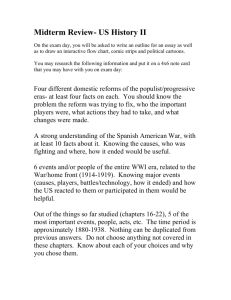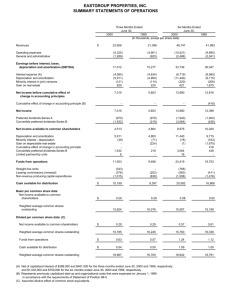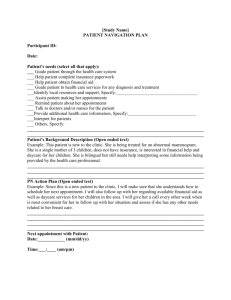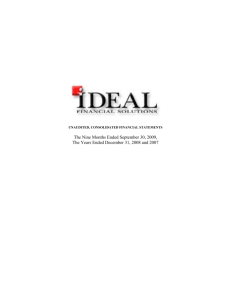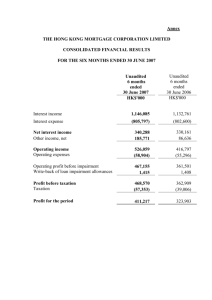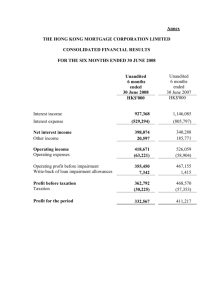Second Quarter 10-Q - Smith
advertisement
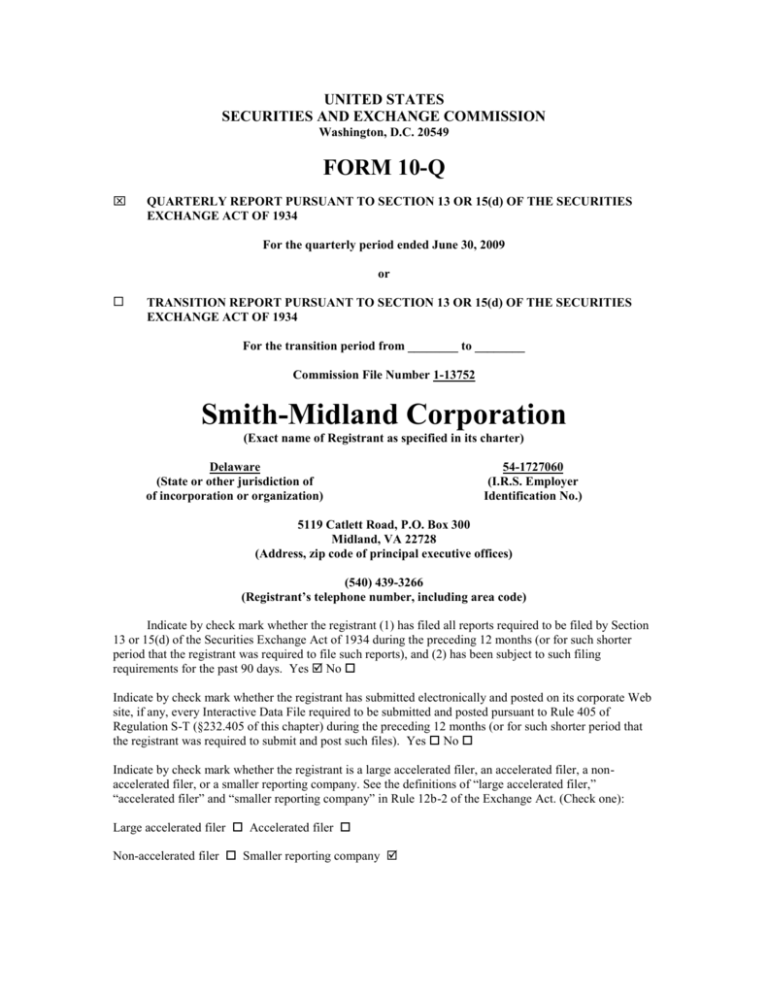
UNITED STATES SECURITIES AND EXCHANGE COMMISSION Washington, D.C. 20549 FORM 10-Q QUARTERLY REPORT PURSUANT TO SECTION 13 OR 15(d) OF THE SECURITIES EXCHANGE ACT OF 1934 For the quarterly period ended June 30, 2009 or TRANSITION REPORT PURSUANT TO SECTION 13 OR 15(d) OF THE SECURITIES EXCHANGE ACT OF 1934 For the transition period from ________ to ________ Commission File Number 1-13752 Smith-Midland Corporation (Exact name of Registrant as specified in its charter) Delaware (State or other jurisdiction of of incorporation or organization) 54-1727060 (I.R.S. Employer Identification No.) 5119 Catlett Road, P.O. Box 300 Midland, VA 22728 (Address, zip code of principal executive offices) (540) 439-3266 (Registrant’s telephone number, including area code) Indicate by check mark whether the registrant (1) has filed all reports required to be filed by Section 13 or 15(d) of the Securities Exchange Act of 1934 during the preceding 12 months (or for such shorter period that the registrant was required to file such reports), and (2) has been subject to such filing requirements for the past 90 days. Yes No Indicate by check mark whether the registrant has submitted electronically and posted on its corporate Web site, if any, every Interactive Data File required to be submitted and posted pursuant to Rule 405 of Regulation S-T (§232.405 of this chapter) during the preceding 12 months (or for such shorter period that the registrant was required to submit and post such files). Yes No Indicate by check mark whether the registrant is a large accelerated filer, an accelerated filer, a nonaccelerated filer, or a smaller reporting company. See the definitions of “large accelerated filer,” “accelerated filer” and “smaller reporting company” in Rule 12b-2 of the Exchange Act. (Check one): Large accelerated filer Accelerated filer Non-accelerated filer Smaller reporting company Indicate by check mark whether the registrant is a shell company (as defined in Rule 12b-2 of the Exchange Act). Yes No Indicate the number of shares outstanding of each of the issuer’s classes of common stock, as of the latest practicable date. Common Stock, $.01 par value, outstanding as of August 10, 2009: 4,629,962 shares, net of treasury shares SMITH-MIDLAND CORPORATION Form 10-Q Index Page PART I. FINANCIAL INFORMATION Item 1. Financial Statements Condensed Consolidated Balance Sheets (Unaudited), June 30, 2009 and December 31, 2008 3 Condensed Consolidated Statements of Operations (Unaudited) for the three months ended June 30, 2009 and June 30, 2008 5 Condensed Consolidated Statements of Operations (Unaudited) for the six months ended June 30, 2009 and June 30, 2008 6 Condensed Consolidated Statements of Cash Flows (Unaudited) for the six months ended June 30, 2009 and June 30, 2008 7 Notes to Condensed Consolidated Financial Statements (Unaudited) 8 Management’s Discussion and Analysis of Financial Condition and Results of Operations 12 Item 3. Quantitative and Qualitative Disclosures About Market Risk 17 Item 4T. Controls and Procedures 17 Item 2. PART II. Item 6 OTHER INFORMATION Exhibits 18 Exhibit 31.1 Exhibit 31.2 Exhibit 32 Signatures 19 PART I — FINANCIAL INFORMATION ITEM 1. Financial Statements SMITH-MIDLAND CORPORATION CONDENSED CONSOLIDATED BALANCE SHEETS (Unaudited) June 30, 2009 December 31, 2008 Assets: Current Assets: Cash and cash equivalents $ 2,256,252 $ Accounts receivable Trade- billed (less allowance for doubtful accounts of $268,448, and $396,665, respectively) 5,387,242 Trade – unbilled 121,117 Inventories Raw materials 783,014 Finished goods 1,534,396 Prepaid expenses and other assets 95,762 Prepaid income taxes Deferred tax asset 414,000 Total current assets Property and equipment, net Other assets Total assets 1,363,284 5,831,182 660,165 851,394 1,572,830 155,772 258,150 471,000 10,591,783 11,163,777 4,279,303 154,660 4,223,555 163,735 $15,025,746 $ 15,551,067 The accompanying notes are an integral part of the condensed consolidated financial statements. SMITH-MIDLAND CORPORATION CONDENSED CONSOLIDATED BALANCE SHEETS (Unaudited) June 30, 2009 Liabilities and Shareholders’ Equity: Current Liabilities: Accounts payable – trade Accrued income taxes payable Accrued expenses and other liabilities Current maturities of notes payable Customer deposits December 31, 2008 $ 1,329,050 $ 183,090 654,548 483,471 556,546 2,142,478 1,074,889 1,022,476 858,437 Total current liabilities 3,206,705 5,098,280 Notes payable – less current maturities Deferred taxes 3,227,364 336,000 3,569,321 317,000 Total liabilities 6,770,069 8,984,601 - - Commitments and Contingencies Shareholders’ Equity: Preferred stock, par value $.01 per share; authorized 1,000,000 shares; none issued and outstanding Common stock, par value $.01 per share; authorized 8,000,000 shares; issued and outstanding 4,670,882 Additional paid-in capital Retained earnings Treasury Stock, at cost, 40,920 shares Total shareholders’ equity Total liabilities and shareholders’ equity 46,709 4,753,352 3,557,916 (102,300) 46,709 4,701,820 1,920,237 (102,300) 8,255,677 6,566,466 $15,025,746 $ 15,551,067 The accompanying notes are an integral part of the condensed consolidated financial statements. SMITH-MIDLAND CORPORATION CONDENSED CONSOLIDATED STATEMENTS OF OPERATIONS (Unaudited) Three Months Ended June 30, 2009 2008 Revenue Product sales and leasing Shipping and installation revenue Royalties $6,136,732 $5,388,218 1,067,236 1,066,227 393,617 425,933 Total revenue 7,597,585 6,880,378 Cost of goods sold 4,905,919 5,114,634 Gross profit 2,691,666 1,765,744 892,585 558,494 745,048 617,636 Total operating expenses 1,451,079 1,362,684 Operating income 1,240,587 403,060 Operating expenses General and administrative expenses Selling expenses Other income (expense): Interest expense Interest income Gain (loss) on sale of fixed assets Other, net Total other expense (59,627) 529 4,279 (117) (54,936) Income before income tax expense Income tax expense (84,477) 17,608 (8,574) (80) (75,523) 1,185,651 327,537 488,000 128,000 Net income $ 697,651 $ 199,537 Net income per common share: Basic Diluted $ $ Weighted average number of common shares outstanding: Basic Diluted 0.15 $ 0.15 $ 4,670,882 4,775,149 0.04 0.04 4,670,882 4,789,818 The accompanying notes are an integral part of the condensed consolidated financial statements. SMITH-MIDLAND CORPORATION CONDENSED CONSOLIDATED STATEMENTS OF OPERATIONS (Unaudited) Six Months Ended June 30, 2009 2008 Revenue Product sales and leasing Shipping and installation revenue Royalties $13,484,224 $11,322,630 2,411,432 1,750,727 835,869 699,662 Total revenue 16,731,525 13,773,019 Cost of goods sold 11,217,123 10,380,495 Gross profit 5,514,402 3,392,524 Operating expenses General and administrative expenses Selling expenses 1,573,970 1,127,281 1,526,217 1,263,608 Total operating expenses 2,701,251 2,789,825 Operating income 2,813,151 602,699 Other income (expense): Interest expense Interest income Gain (loss) on sale of fixed assets Other, net Total other expense (121,332) 1,014 24,102 (256) (96,472) (183,857) 19,998 (6,559) (257) (170,675) Income before income tax expense 2,716,679 432,024 Income tax expense 1,079,000 181,000 Net income $ 1,637,679 $ 251,024 Net income per common share: Basic Diluted $ $ Weighted average number of common shares outstanding: Basic Diluted 0.35 $ 0.35 $ 4,670,882 4,733,982 0.05 0.05 4,670,882 4,790,008 The accompanying notes are an integral part of the condensed consolidated financial statements. SMITH-MIDLAND CORPORATION AND SUBSIDIARIES CONDENSED CONSOLIDATED STATEMENTS OF CASH FLOWS (Unaudited) Six Months Ended June 30, 2009 2008 Reconciliation of net income to cash provided (absorbed) by operating activities Net income Adjustments to reconcile net income to net cash provided (absorbed) by operating activities: Depreciation and amortization Stock option compensation expense (Gain) loss on disposal of fixed assets Deferred taxes (Increase) decrease in: Accounts receivable - billed Accounts receivable - unbilled Inventories Prepaid taxes and other assets Increase (decrease) in: Accounts payable - trade Accrued expenses and other Accrued income taxes payable Customer deposits Net cash provided by operating activities $1,637,679 $ 251,024 347,187 51,532 (24,102) 76,000 333,011 62,073 6,559 (4,000) 443,940 539,048 106,814 327,873 965,202 (187,602) (249,827) 294,475 (813,561) (420,341) 183,090 (301,891) 68,535 (74,328) (617,566) 118,886 2,153,268 966,442 Cash flows from investing activities: Purchases of property and equipment Proceeds from sale of fixed assets (421,626) 42,288 (308,779) 8,632 Net cash absorbed by investing activities (379,338) (300,147) Cash flows from financing activities: Proceeds (repayments) on lines of credit, net Proceeds from long-term borrowings Repayments of long-term borrowings and capital leases (500,000) (380,962) 800,000 138,008 (232,621) Net cash (absorbed) provided by financing activities (880,962) 705,387 Net increase in cash and cash equivalents Cash and cash equivalents Beginning of period End of period 892,968 1,371,682 1,363,284 282,440 $2,256,252 $1,654,122 The accompanying notes are an integral part of the condensed consolidated financial statements. SMITH-MIDLAND CORPORATION NOTES TO CONDENSED CONSOLIDATED FINANCIAL STATEMENTS (Unaudited) NOTE 1. – INTERIM FINANCIAL REPORTING Basis of Presentation The accompanying condensed consolidated financial statements were prepared in accordance with accounting principles generally accepted in the United States of America for interim financial information, and with the instructions to Form 10-Q and Article 10 of Regulation S-X. Accordingly, we have condensed or omitted certain information and footnote disclosures that are included in our annual financial statements. These condensed consolidated financial statements should be read in conjunction with the audited consolidated financial statements and the related notes included in our Annual Report on Form 10-K for the year ended December 31, 2008. The December 31, 2008 balance sheet was derived from audited financial statements included in the Form 10-K. In the opinion of management, these condensed consolidated financial statements reflect all adjustments (which consist of normal, recurring adjustments) necessary for a fair presentation of the financial position and results of operations and cash flows for the periods presented.The results disclosed in the condensed consolidated statements of income are not necessarily indicative of the results to be expected in any future periods. The Company has evaluated subsequent events from the date of the financial statements through the date of the filing of this Form 10-Q. During this period, no material recognizable subsequent events were identified. Use of Estimates The preparation of financial statements in conformity with generally accepted accounting principles requires management to make estimates and assumptions that affect the reported amounts of assets and liabilities at the date of the financial statements and the reported amounts of revenues and expenses during the reporting period. Actual results could differ from those estimates. Revenue Recognition The Company primarily recognizes revenue on the sale of its standard precast concrete products at shipment date, including revenue derived from any projects to be completed under short-term contracts. Installation of the Company’s standard products is typically performed by the customer; however, in some circumstances, the Company will install certain products which are accomplished at the time of delivery. The installation activities are usually completed the day of delivery or the following day. In utility building sales, the majority of the buildings are erected on the Company’s site and delivered completely installed. Leasing fees are paid at the beginning of the lease agreement and recorded to a deferred revenue account. As the revenue is earned each month during the contract, the amount earned is recorded as lease income and an equivalent amount is debited to deferred revenue. Royalties are recognized as revenue as they are earned. The Company licenses certain other precast companies to produce its licensed products to our engineering specifications under licensing agreements. The agreements are typically for five year terms and require royalty payments from 4% to 6% which are paid on a monthly basis. The revenue from licensing agreements is recognized in the month earned. Certain sales of Soundwall, architectural precast panels and Slenderwall™ concrete products revenue is recognized using the percentage of completion method for recording revenues on long term contracts under ARB 45 and SOP 81-1. The contracts are executed by both parties and clearly stipulate the requirements for progress payments and a schedule of delivery dates. Provisions for estimated losses on contracts are made in the period in which such losses are determined. Shipping revenues are recognized in the period the shipping services are provided to the customer. Smith-Midland products are typically sold pursuant to an implicit warranty as to merchantability only. Warranty claims are reviewed and resolved on a case by case method. Although the Company does incur costs for these types of expense, historically the amount of expense is immaterial. Reclassifications Certain immaterial reclassifications have been made to the prior year’s condensed consolidated financial statements to conform to the 2009 presentation. NOTE 2. – NET INCOME PER COMMON SHARE Basic earnings per common share exclude all dilutive stock options and are computed using the weighted average number of common shares outstanding during the period. The diluted earnings per common share calculation reflect the potential dilutive effect of securities that could share in earnings of an entity. Outstanding options excluded from the diluted earnings per share calculation because they would have an anti-dilutive effect were 260,666 and 288,166 from the three months ended June 30, 2009 and 2008, respectively and 429,491 and 288,166 from the six months ended June 30, 2009 and 2008, respectively. Three Months ended June 30, 2009 2008 Basic earnings per share Income available to common shareholder $ 697,651 $ 199,537 Weighted average shares outstanding Basic earnings per share 4,670,882 $ 0.15 $ 4,670,882 0.04 Diluted earnings per share Income available to common shareholder $ 697,651 $ 199,537 Weighted average shares outstanding Dilutive effect of stock options 4,670,882 104,267 4,670,882 118,936 Diluted weighted average shares outstanding 4,775,149 4,789,818 Diluted earnings per share $ 0.15 $ 0.04 Six Months ended June 30, 2009 2008 Basic earnings per share Income available to common shareholder $1,637,679 $ 251,024 Weighted average shares outstanding Basic earnings per share 4,670,882 $ 4,670,882 0.35 $ 0.05 Diluted earnings per share Income available to common shareholder $1,637,679 $ 251,024 Weighted average shares outstanding Dilutive effect of stock options 4,670,882 63,100 4,670,882 119,126 Diluted weighted average shares outstanding 4,733,982 4,790,008 Diluted earnings per share $ 0.35 $ 0.05 NOTE 3. – NOTES PAYABLE Line of Credit On May 29, 2009, Smith-Midland Corporation completed the refinance of its existing line of credit with Greater Atlantic Bank in the amount of $1,500,000 with Summit Community Bank under substantially the same terms. The line of credit with Summit Community Bank will mature on May 28, 2010, and carries an interest rate of prime (the Wall Street Journal U.S. Prime Rate) with a floor of 4.75% per annum. The current interest rate under the line of credit is 4.75% per annum. Interest is required to be paid monthly. The line of credit is secured by a first lien on accounts receivable and inventory and a second lien on all equipment. Advances outstanding on the respective lines of credit were $500,000 at December 31, 2008. There was no balance outstanding at June 30, 2009. Key provisions of the line of credit require the Company, (i) to obtain bank approval for capital expenditures in excess $700,000 during the term of the loan; (ii) to maintain a minimum tangible equity of $5,000,000; and (iii) to obtain bank approval prior to the payment of dividends on the Company’s common stock. Equipment Purchase Commitment On April 8, 2009, the Company received a commitment from Summit Community Bank to provide a guidance line of credit specifically for the purchase of equipment in the amount of $700,000 with an effective date of May 29, 2009. The commitment provides for the purchase of equipment in with minimum advances of $50,000 for which a note payable will be executed with a term not to exceed five years and an interest rate of prime (the Wall Street Journal U.S. Prime Rate) plus .5% with a floor of 4.75% per annum. The current interest rate under the equipment purchase commitment is 4.75% per annum. The notes payable will require monthly payments of principal and interest during the term of the notes. The notes payable will be secured by a first lien on the purchased equipment. The commitment for the guidance line of credit will mature on May 28, 2010. There were no advances under the equipment purchase commitment as of June 30, 2009. The key provisions of the guidance line of credit are the same as those of the Summit Community Bank line of credit more fully described above. Loan Payoffs The balance of the Greater Atlantic Bank line of credit and an additional term loan were paid off in May 2009 with available cash. NOTE 4. – STOCK OPTIONS In accordance with SFAS 123R, stock option expense for the three months ended June 30, 2009 and 2008 was $27,017 and $31,538 respectively, and for the six months ended June 30, 2009 and 2008 was $51,532 and $62,073, respectively. The Company uses the Black-Scholes option-pricing model to measure the fair value of stock options granted to employees. The Company did not issue any stock options for the six months ended June 30, 2009. The following table summarized options outstanding at June 30, 2009: Outstanding options at beginning of period Granted Forfeited Exercised Number of Shares 642,157 (15,000) - Weighted Average Exercise Price $ 1.52 1.38 - Outstanding options at end of period 628,490 $ 1.54 Outstanding exercisable at end of period 521,272 $ 1.56 The intrinsic value of outstanding and exercisable options at June 30, 2009 is approximately $255,000 and $217,000, respectively. NOTE 5. – RECENT PRONOUNCEMENTS In April 2009, the FASB issued FSP FAS 107-1 and APB 28-1, “Interim Disclosures about Fair Value of Financial Instruments” (“FSP FAS 107-1 and APB28-1”). This FSP amends FASB Statement No. 107, “Disclosures about Fair Values of Financial Instruments,” to require disclosures about the fair values of financial instruments for interim reporting periods of publicly traded companies as well as in annual financial statements. The FSP also amends APB Opinion No. 28, “Interim Financial Reporting,” to require those disclosures in summarized financial information at interim reporting periods. FSP FAS 107-1 and APB 28-1 became effective for interim and annual reporting periods ending after June 15, 2009. The Company adopted the FSP for the period ended June 30, 2009. In May 2009, the FASB issued SFAS No. 165, Subsequent Events” (“SFAS No. 165”), which establishes general standards of accounting for and disclosure of events that occur after the balance sheet date but before the financial statements are issued or are available to be issued. It requires the disclosure of the date through which an entity has evaluated subsequent events and the basis for that date. The Statement sets forth the period after the balance sheet date during which management of a reporting entity should evaluate events or transactions that may occur for potential recognitions or disclosure in the financial statements the circumstances under which an entity should recognize events or transactions that occurred after the balance sheet date in its financial statements and the disclosures that an entity should make about events or transactions that occurred after the balance sheet date. SFAS No. 165 became effective for the Company for the period ended June 30, 2009 and is to be applied prospectively. The impact of adoption was not significant. In June 2009, the FASB issued SFAS No. 168, “The FASB Accounting Standard Codification™ (“Codification”) and the Hierarchy of Generally Accepted Accounting Principles,” effective for interim and annual reporting periods ending after September 15, 2009. This statement replaces SFAS No. 162, “The Hierarchy of Generally Accepted Accounting Principles” and establishes the Codification as the source of authoritative accounting principles used in the preparation of financial statements in conformity with generally accepted accounting principles. The Codification does not replace or affect guidance issued by the SEC or its staff. After the effective date of this statement, all non-grandfathered non-SEC accounting literature not included in the Codification will be superseded and deemed non-authoritative. ITEM 2. Operations Management’s Discussion and Analysis of Financial Condition and Results of Forward-Looking Statements This Quarterly Report and related documents include “forward-looking statements” within the meaning of Section 27A of the Securities Act and Section 21E of the Exchange Act. Forward-looking statements involve known and unknown risks, uncertainties and other factors which could cause the Company’s actual results, performance (financial or operating) or achievements expressed or implied by such forward looking statements not to occur or be realized. Such forward looking statements generally are based upon the Company’s best estimates of future results, performance or achievement, based upon current conditions and the most recent results of operations. Forward-looking statements may be identified by the use of forward-looking terminology such as “may,” “will,” “expect,” “believe,” “estimate,” “anticipate,” “continue,” or similar terms, variations of those terms or the negative of those terms. Potential risks and uncertainties include, among other things, such factors as: our high level of indebtedness and ability to satisfy the same, the continued availability of financing in the amounts, at the times, and on the terms required, to support our future business and capital projects, the extent to which we are successful in developing, acquiring, licensing or securing patents for proprietary products, changes in economic conditions specific to any one or more of our markets (including the availability of public funds and grants for construction), changes in general economic conditions, such as the continuing economic downturn in the construction industry. adverse weather which inhibits the demand for our products, our compliance with governmental regulations, the outcome of future litigation, on material construction projects, our ability to produce and install product that conforms to contract specifications and in a time frame that meets the contract requirements , the cyclical nature of the construction industry, our exposure to increased interest expense payments should interest rates change the Board of Directors, which is composed of four members, has only one outside, independent director, the Company does not have an audit committee; the Board of Directors functions in that role, the Company’s Board of Directors does not have a member that qualifies as an audit committee financial expert as defined in the regulations, the Company has experienced a high degree of employee turnover, and the other factors and information disclosed and discussed in other sections of this report, and in our Annual Report on Form 10-K for the fiscal year ended December 31, 2008. Investors and shareholders should carefully consider such risks, uncertainties and other information, disclosures and discussions which contain cautionary statements identifying important factors that could cause actual results to differ materially from those provided in the forward-looking statements. We undertake no obligation to publicly update or revise any forward-looking statements, whether as a result of new information, future events or otherwise. Overview Smith-Midland Corporation (the "Company") invents, develops, manufactures, markets, leases, licenses, sells, and installs a broad array of precast concrete products for use primarily in the construction, utilities and farming industries. The Company's customers are primarily general contractors and federal, state, and local transportation authorities located in the Mid-Atlantic, Northeastern, and Midwestern regions of the United States. The Company's operating strategy has involved producing innovative and proprietary products, including Slenderwall , a patented, lightweight, energy efficient concrete and steel exterior wall panel for use in building construction; J-J Hooks Highway Safety Barrier, a patented, positive-connected highway safety barrier; Sierra Wall, a sound barrier primarily for roadside use; and Easi-Set® transportable concrete buildings, also patented. In addition, the Company produces custom order precast concrete products with various architectural surfaces, as well as generic highway sound barriers, utility vaults, and farm products such as cattleguards and water and feed troughs. The Company was incorporated in Delaware on August 2, 1994. Prior to a corporate reorganization completed in October 1994, the Company conducted its business primarily through Smith-Midland Virginia, which was incorporated in 1960 as Smith Cattleguard Company, a Virginia corporation, and which subsequently changed its name to Smith-Midland Corporation in 1985. The Company’s principal offices are located at 5119 Catlett Road, Midland, Virginia 22728 and its telephone number is (540) 4393266. As used in this report, unless the context otherwise requires, the term the “Company” refers to Smith-Midland Corporation and its subsidiaries. The Company’s results for the first half of 2009 were very positive, particularly in view of the current economic recession. However, it is likely that the results of operations for the remainder of the year will be less positive in view of the recent trend toward more aggressive project bidding by the Company’s competitors and continued reduced construction activity. In the near future, the Company believes that its results of operations may be favorably affected by the government stimulus package which is geared toward infrastructure spending. Results of Operations Three months ended June 30, 2009 compared to the three months ended June 30, 2008 Revenue: For the three months ended June 30, 2009, the Company had total revenue of $7,597,585 compared to total revenue of $6,880,378 for the three months ended June 30, 2008, an increase of $717,207 or 10%. Total product sales and leasing were $6,136,732 for the three months ended June 30, 2009 compared to $5,388,218 for the three months ended June 30, 2008, an increase of $748,514 or 14%. In the wall sales category, soundwall sales decreased by $1,128,825 from the prior year while architectural wall sales increased by $2,510,397 so that combined wall sales increased by $1,381,573 or 38%. The change in soundwall and architectural wall sales relates to the types of contracts in production during the reporting period. There were no Slenderwall™ sales in the three months ended June 30, 2009 or 2008 due to increased marketing efforts in architectural products and market demand. Sales of Easi-Set® precast buildings decreased by $113,756 or 27% to $416,905 for the three months ended June 30, 2009 over the same period in 2008. Utility and farm product sales decreased by $92,551 or 17% due to decreased construction activity by state and local governments. Highway barrier sales decreased by $395,887 or 37%, due to the economic slowdown in state and federal spending on road projects. Royalty revenue for the three months ended June 30, 2009 was $393,617 compared to $425,933 for the three months ended June 30, 2008, a decrease of $32,316 or 8%. Shipping and installation revenue increased by $1,009 or 1% for the three months ended June 30, 2009 over the same period in 2008. Cost of Goods Sold: Total cost of good sold for the three months ended June 30, 2009 was $4,905,919, a decrease of $208,715 or 4%. While sales increased by 10% for the three months ended June 30, 2009 over the same period in 2008, the cost of goods sold decreased because of the following factors: The cost of raw materials and fuel were at record highs for the three months ended June 30, 2008 as compared to the same period in 2009. In addition, with the implementation of lean manufacturing in late 2008, the Company was able to reduce overtime as well as reduce waste in several manufacturing processes. Lean manufacturing is defined as the process of using the minimum amount of total resources – man, materials, money, machines, etc. – to produce a product and deliver it on time. As a result of the moderating costs and the implementation of lean manufacturing, the cost of goods sold as a percentage of total revenue not including royalties for the three months ended June 30, 2009 was 68% as compared to 79% for the same period in 2008. The Company plans to continue to make the reduction of manufacturing costs the highest priority in 2009 through the implementation of lean manufacturing practices. General and Administrative Expenses: For the three months ended June 30, 2009, the Company’s general and administrative expenses increased $147,537 or 20% to $892,585 from $745,048 during the same period in 2008. The increase was primarily due to use taxes due on the $2,510,397 increased architectural product sales installed by the Company for the three months ended June 30, 2009 over the same period in 2008. Selling Expenses: Selling expenses for the three months ended June 30, 2009 were $558,494, a decrease of $59,142 or 10% from $617,636 for the same period in 2008. The decrease was primarily due to decreased advertising costs and lower sales commissions. Operating Income: The Company had operating income of $1,240,587 for the three months June 30, 2009, compared to operating income of $403,060 for the same period in 2008, an increase of $837,527 or 208%. The increase in operating income was primarily the result of increased sales and decreased cost of goods sold as a percentage of revenues. Interest expense: Interest expense was $59,627 for the three months ended June 30, 2009, compared to $84,477 in 2008, a decrease of $24,850 or 29%. The decrease was due primarily to a decrease in prevailing interest rates and payment of outstanding debt during the period. Net Income: The Company had net income of $697,651 for the three months ended June 30, 2009, as compared to net income of $199,537 for the same period in 2008. The basic and diluted net income per common share for the three month period ending June 30, 2009 was $.15 as compared to $.04 for the same period in 2008. Six months ended June 30, 2009 compared to the Six months ended June 30, 2008 Revenue: For the six months ended June 30, 2009, the Company had total revenue of $16,731,525 compared to total revenue of $13,773,019 for the six months ended June 30, 2008, an increase of $2,958,506 or 21%. Total product sales and leasing were $13,484,224 for the six months ended June 30, 2009 compared to $11,322,630 for the six months ended June 30, 2008, an increase of $2,161,594 or 19%. In the wall sales category, soundwall sales decreased by $1,934,015 from the prior year while architectural wall sales increased by $3,499,718 so that combined wall sales increased by $1,565,703 or 23%. The change in soundwall and architectural wall sales relates to the types of contracts in production during the reporting period. There were no Slenderwall™ sales in the six months ended June 30, 2009 or June 30, 2008 due primarily to increased marketing efforts in architectural products and market demand. Sales of Easi-set® precast buildings increased by $543,527 or 32% to $1,692,609 for the six months ended June 30, 2009 over the same period in 2008. Lower revenues from utility and farm products of $54,288 partially offset the increase in sales. Highway barrier sales decreased by $1,258,597 or 79% due to the economic slowdown in state and federal spending on road projects. Royalty revenue for the six months ended June 30, 2009 was $835,869 compared to $699,662 for the six months ended June 30, 2008, an increase of $136,207 or 19%. Shipping and installation revenue increased by $660,705 or 38% for the six months ended June 30, 2009 over the same period in 2008. The increase was primarily due to increased shipping activity related to the rental of highway barrier for the presidential inauguration during the month of January 2009 in Washington, D.C. and an increase in the sale of architectural products. Cost of Goods Sold: Total cost of good sold for the six months ended June 30, 2009 was $11,217,123, an increase of $836,628 or 8%. The increase was primarily due to the increased revenue as described above. During the first half of 2008, the Company realized significant increases in the cost of steel, cement and other direct materials used in production and delivery costs including fuel surcharges, while, in second half of 2008 and the first six months of 2009, the Company experienced moderation in the cost increases experienced in early 2008. In addition, with the implementation of lean manufacturing in late 2008, the Company was able to reduce overtime as well as reduce waste in several manufacturing processes As a result of increased sales, moderating costs and the implementation of lean manufacturing the cost of goods sold as a percentage of total revenue not including royalties for the six months ended June 30, 2009 was 71% as compared to 79% for the same period in 2008. The Company continues to make the reduction of manufacturing costs the highest priority in 2009 through the implementation of lean manufacturing practices. General and Administrative Expenses: For the six months ended June 30, 2009, the Company’s general and administrative expenses increased $47,753 or 3% to $1,573,970 from $1,526,217 during the same period in 2008. The increase was primarily due to use taxes due on increased sales of architectural products installed by the Company which was partially offset by reduced professional fees associated with the temporary use of an outside firm to provide finance and accounting oversight. Selling Expenses: Selling expenses for the six months ended June 30, 2009 were $1,127,281, a decrease of $136,327 or 11% from $1,263,608 for the same period in 2008. The decrease was primarily due to decreased advertising costs and lower sales commissions. Operating Income: The Company had operating income of $2,813,151 for the six months June 30, 2009, compared to operating income of $602,699 for the same period in 2008, an increase of $2,210,452 or 367%. The increase in operating income was primarily the result of increased sales and decreased cost of goods sold as a percentage of revenues. Interest expense: Interest expense was $121,332 for the six months ended June 30, 2009, compared to $183,857 for the same period in 2008, a decrease of $62,525 or 34%. The decrease was due primarily to a decrease in prevailing interest rates and the payment of outstanding debt during the period. Net Income: The Company had net income of $1,637,679 for the six months ended June 30, 2009, as compared to net income of $251,024 for the same period in 2008. The basic and diluted net income per common share for the six month period ending June 30, 2009 was $.35 as compared to $.05 for the same period in 2008. Liquidity and Capital Resources The Company has financed its capital expenditures and operating requirements to date in 2009 primarily from net cash generated from operating activities. The Company had $3,710,835 of debt obligations at June 30, 2009, of which $483,471 was scheduled to mature within twelve months. The Company has a $1,500,000 line of credit, of which none was outstanding at June 30, 2009. The line of credit is evidenced by a commercial revolving promissory note, which carries a variable interest rate of prime and matures on May 28, 2010. In addition, the Company has a commitment from Summit Community Bank in the amount of $700,000 for an equipment line of credit which expires on May 28, 2010. At June 30, 2009, the Company had cash totaling $2,256,252 compared to cash totaling $1,363,284 on December 31, 2008. During the period, operating activities contributed $2,153,268, investing activities absorbed $379,338, and financing activities absorbed $880,962. Capital spending totaled $421,626 for the six months ended June 30, 2009, as compared to $308,779 for the same period in 2008. The 2009 expenditures are primarily for the upgrade and replacement of equipment in the precast plant. The Company plans to make additional capital expenditures for routine equipment replacement, productivity improvements, and plant upgrades, which are planned through 2009 based on the achievement of operating goals and the availability of funds. As a result of the Company’s existing debt burden, the Company is sensitive to changes in the prevailing interest rates. Increases in such rates may materially and adversely affect the Company’s ability to finance its operations either by increasing the Company’s cost to service its current debt, or by creating a more burdensome refinancing environment. Each 1% increase in interest rates affecting the Company’s outstanding debt will reduce income by approximately $37,000 annually. The Company’s cash flow from operations is affected by production schedules set by contractors, which generally provide for payment 35 to 75 days after the products are produced. This payment schedule has resulted in liquidity problems in the past for the Company because it must bear the cost of production for its products before it receives payment. The Company’s days sales outstanding decreased from 75 days at December 31, 2008 to 74 days at June 30, 2009. Although no assurances can be given, the Company believes that anticipated cash flow from operations and the available line of credit will be sufficient to finance the Company’s operations for at least the next twelve months. The Company’s inventory was $2,317,410 at June 30, 2009 and at December 31, 2008 was $2,424,224 or a decrease of $106,814. Inventory turnover remained 8.8 at December 31, 2008 and June 30, 2009, on an annualized basis. Critical Accounting Policies and Estimates The Company’s critical accounting policies are more fully described in its Summary of Accounting Policies to the Company’s consolidated financial statements on Form 10-K for the year ended December 31, 2008. The preparation of financial statements in conformity with accounting principles generally accepted within the United States requires management to make estimates and assumptions in certain circumstances that affect amounts reported in the accompanying financial statements and related notes. In preparing these financial statements, management has made its best estimates and judgments of certain amounts included in the financial statements, giving due consideration to materiality. The Company does not believe there is a great likelihood that materially different amounts would be reported related to the accounting policies described below, however, application of these accounting policies involves the exercise of judgment and the use of assumptions as to future uncertainties and as a result, actual results could differ from these estimates. The Company evaluates the adequacy of its allowance for doubtful accounts at the end of each quarter. In performing this evaluation, the Company analyzes the payment history of its significant past due accounts, subsequent cash collections on these accounts and comparative accounts receivable aging statistics. Based on this information, along with other related factors, the Company develops what it considers to be a reasonable estimate of the uncollectible amounts included in accounts receivable. This estimate involves significant judgment by the management of the Company. Actual uncollectible amounts may differ from the Company’s estimate. The Company recognizes revenue on the sale of its standard precast concrete products at shipment date, including revenue derived from any projects to be completed under short-term contracts. Installation services for precast concrete products, leasing and royalties are recognized as revenue as they are earned on an accrual basis. Licensing fees are recognized under the accrual method unless collectibility is in doubt, in which event revenue is recognized as cash is received. Certain sales of Soundwall, Slenderwall™, and other architectural concrete products are recognized upon completion of units produced under long-term contracts. When necessary, provisions for estimated losses on these contracts are made in the period in which such losses are determined. Changes in job performance, conditions and contract settlements that affect profit are recognized in the period in which the changes occur. Unbilled trade accounts receivable represents revenue earned on units produced and not yet billed. Seasonality The Company services the construction industry primarily in areas of the United States where construction activity may be inhibited by adverse weather during the winter. As a result, the Company may experience reduced revenues from December through February and realize the substantial part of its revenues during the other months of the year. The Company may experience lower profits, or losses, during the winter months, and as such, must have sufficient working capital to fund its operations at a reduced level until the spring construction season. The failure to generate or obtain sufficient working capital during the winter may have a material adverse effect on the Company. Inflation Significant increases in the cost of steel, cement and other direct materials used in production and delivery, including fuel surcharges caused an increase in the cost of goods sold for the Company during the year ending December 31, 2008. As the downturn in the economy increased, these costs began to moderate during the last quarter of 2008. As the downturn in the economy has continued into 2009, the Company expects these costs to continue to moderate during 2009. Production Backlog As of July 31, 2009, the Registrant’s sales backlog was approximately $13,000,000, as compared to approximately $16,000,000 at the same date in 2008. The Company also maintains a regularly occurring repeat customer business, which should be considered in addition to the ordered production backlog described above. These orders typically have a quick turn around and represent purchases of a significant portion of the Company’s inventoried standard products, such as highway safety barrier, utility and EasiSet® building products. Historically, this regularly occurring repeat customer business has been approximately $6,500,000 annually. ITEM 3. Quantitative and Qualitative Disclosures About Market Risk Not Applicable ITEM4T.Controls and Procedures (a) Disclosure controls and procedures We carried out our evaluation, under the supervision and with the participation of our management, including our chief executive officer and chief financial officer, of the effectiveness of our disclosure controls and procedures as of the end of the period covered by this report, pursuant to Rules 13a15(e) and 15d-15(e) under the Securities Exchange Act of 1934, as amended. Based on this evaluation, the chief executive officer and chief financial officer have concluded that the Company’s disclosure controls and procedures were effective at June 30, 2009. (b) Changes in Internal Control over Financial Reporting There has been no change in the Company’s internal control over financial reporting during the six months ended June 30, 2009 that has materially affected, or is reasonably likely to materially affect, its internal control over financial reporting. PART II — OTHER INFORMATION ITEM 6. Exhibit No. Exhibits Exhibit Description 31.1 Certification of the Chief Executive Officer pursuant to Rule 13a-14(a) or 15d-14(a) under the Securities Exchange Act of 1934. 31.2 Certification of the Principal Financial Officer pursuant to Rule 13a-14(a) or 15d-14(a) under the Securities Exchange Act of 1934. 32.1 Certification pursuant 18 U.S.C. Section 1350 as adapted pursuant to Section 906 of the Sarbanes-Oxley Act of 2002 SIGNATURES Pursuant to the requirements of the Securities Exchange Act of 1934, the registrant has duly caused this report to be signed on its behalf by the undersigned thereunto duly authorized. SMITH-MIDLAND CORPORATION (Registrant) Date: August 12, 2009 By: /s/ Rodney I. Smith Rodney I. Smith, President (Principal Executive Officer) Date August 12, 2009 By: /s/ William A. Kenter William A. Kenter, Chief Financial Officer (Principal Financial Officer) Smith-Midland Corporation Exhibit Index to Quarterly Report on Form 10-Q For the Six Months Ended June 30, 2009 Exhibit No 31.1 Exhibit Description Certification of the Chief Executive Officer pursuant to Rule 13a-14(a) or 15d-14(a) under the Securities Exchange Act of 1934. 31.2 Certification of the Principal Financial Officer pursuant to Rule 13a-14(a) or 15d-14(a) under the Securities Exchange Act of 1934. 32.1 Certification pursuant 18 U.S.C. Section 1350 as adapted pursuant to Section 906 of the Sarbanes-Oxley Act of 2002 20


